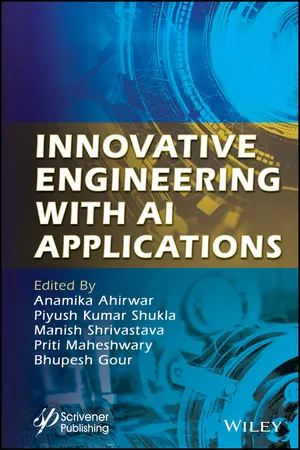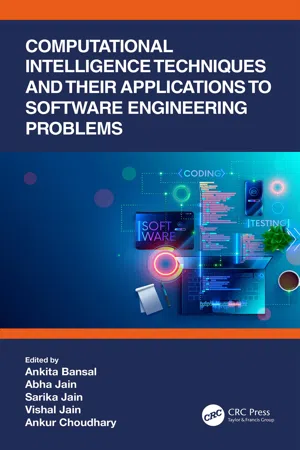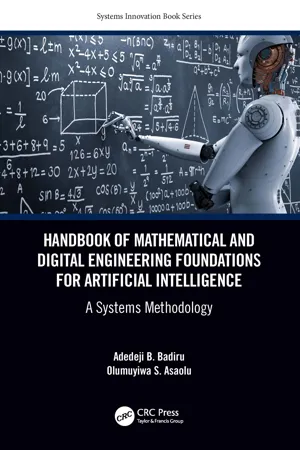Technology & Engineering
AI Engineering
AI engineering involves the application of engineering principles to the development and deployment of artificial intelligence systems. It encompasses the design, construction, and optimization of AI solutions, including machine learning models, algorithms, and data pipelines. AI engineers work to ensure the reliability, scalability, and efficiency of AI technologies in various applications.
Written by Perlego with AI-assistance
Related key terms
1 of 5
9 Key excerpts on "AI Engineering"
- eBook - PDF
- Anamika Ahirwar, Piyush Kumar Shukla, Manish Shrivastava, Priti Maheshwary, Bhupesh Gour(Authors)
- 2023(Publication Date)
- Wiley-Scrivener(Publisher)
To understand this more, learn about the concept of “Value of Perfect Information”. Introduction of AI in Innovative Engineering 7 12. Create a support ecosystem: Build a support ecosystem with the highest quality partners that you can both reach and trust. Many technical leaders are tempted to reach out to the lower quality contacts (as team members, suppliers, partners, and customers) who are easiest to contact, but it is better to push our comfort zones to find the best people and organizations that you can — as long as trust can still be generated. 1.4 Introduction to Artificial Intelligence Artificial intelligence (AI) is the science and engineering of creating intelli- gent machines, with the goal of providing machines the ability to comprehend, reach, and outperform human intelligence. This chapter begins with an over- view of AI’s fundamentals, then moves on to the birth, history, and future of AI in inventive engineering. Then we’ll look at the primary runnel in the field, as well as its evolution and uses in different aspects of our lives. The wrapper will cover the most important and contemporary AI research, such as reinforce- ment learning [2–7], robotics, computer vision, and symbolic logic. To better perceive the term AI, we must always comprehend the term intelligence in an equation shown in Figure1.3. Intelligence is that the abil- ity to find out and solve issues. The foremost common answer that one expects is “to build computers intelligent in order that they will act intelli- gently!”, however the question is what proportion intelligent? However will one decide the intelligence? • Intelligence is the ability to acquire and apply the knowledge. • Knowledge is the information acquired through experience. • Experience is the knowledge gained through exposure (training). - eBook - ePub
Artificial Intelligence, Engineering Systems and Sustainable Development
Driving the UN SDGs
- Tulsi Pawan Fowdur, Satyadev Rosunee, Robert T. F. Ah King, Pratima Jeetah, Mahendra Gooroochurn, Tulsi Pawan Fowdur, Satyadev Rosunee, Robert T. F. Ah King, Pratima Jeetah, Mahendra Gooroochurn(Authors)
- 2024(Publication Date)
- Emerald Publishing Limited(Publisher)
AI enables automation, manages complexity and scalability and leverages data from remote systems in real time. AI methodologies include machine learning (ML), deep learning (DL), optimisation theory, game theory and meta-heuristics (Russell & Norvig, 2020). DL and ML are most commonly used in engineering systems (Fowdur et al., 2021). 1.1.1 Definition and Types of AI The founding father of AI, Alan Turing, defines this discipline as: ‘AI is the science and engineering of making intelligent machines, especially intelligent computer programs. It is usually defined as the science of making computers do things that require intelligence when done by humans’ (Copeland, 2000 ; Deloitte, 2018). There are two main classifications of AI, namely AI based on capabilities and AI based on functionalities. For the classification of AI based on capabilities, there are three main types of AI as follows: Artificial Narrow Intelligence (ANI) : ANI is limited to perform only very specific tasks that it has been trained to perform, such as, playing chess, purchasing suggestions on e-commerce site, self-driving cars, speech recognition and image recognition (Rahman, 2020). Consequently, it is often known as weak AI. It is used in most actual systems, for example, IBM's Watson supercomputer and Apple Siriis. Artificial General Intelligence (AGI) : AGI exhibits human-like understanding and learning capabilities such as sensory-perception, good motor, natural language, creative, complex problem solving and social skills (Goertzel & Pennachin, 2007). AGI systems are currently still being researched and are yet to be deployed in practice. Artificial Super Intelligence (ASI) or Strong AI : AI at this level can surpass human intellect and execute any task with better cognitive qualities - eBook - ePub
- Ankita Bansal, Abha Jain, Sarika Jain, Vishal Jain, Ankur Choudhary, Ankita Bansal, Abha Jain, Sarika Jain, Vishal Jain, Ankur Choudhary(Authors)
- 2020(Publication Date)
- CRC Press(Publisher)
The basic problem phase in SE is a long period of time between the collection and specification of requirements and the release of the software product. Sometimes requirements change before the release of the product, which causes the problem of phase independence; any changes in one phase of the software development process also affect subsequent levels. Therefore, the development team needs to modify the coding of the program when requirements are altered (Saini, 2016).AI is implemented based on perceptions of how the human brain thinks and how a human being becomes skilled and makes a decision to accomplish a task in the steps necessary to resolve a problem. The outcome of this study is used in designing and developing software products and systems. AI is concerned with the study and creation of software systems with a particular aptitude and implements that knowledge in designing a system that can understand natural language. AI understands human perceptions, learning, and reasoning to solve complex problems. AI focuses on creating a system that can behave in a manner that human beings consider intelligent. AI tries to imitate human reasoning in a computer system. AI works with a large amount of data, and then smart algorithms are implemented in the software system to gain knowledge from the available data. AI is a vast subject in the computer science field and includes many advanced and complex processes. The study of this field has combined many theories, methods, and technologies. The major subfields of AI are machine learning, neural networks, deep learning, cognitive computing, and natural language processing.The term AI was coined for the development of intelligent machines. The main goal of AI systems is to create a smart thing or product that can perceive its surroundings and react on the basis of those perceptions. AI is used to design expert systems that uses the knowledge of data instantly to control the process of solution. The expert system can be designed on the basis of knowledge gained from the expert, coding that knowledge in an appropriate form, validating the knowledge and ultimately designing a system with the help of AI tools (Raza, 2009) (Figure 1.2 - eBook - ePub
- Adedeji B. Badiru, Olumuyiwa Asaolu(Authors)
- 2023(Publication Date)
- CRC Press(Publisher)
The above definition demonstrates the versatility and diversity of industrial engineering to enmesh with AI. For the purpose of this book, we are focusing on the “mathematical” angle of industrial engineering. The fact that the most fruitful applications of AI can be found in “industry” further solidifies the linkage of the discipline of industrial engineering to the field of AI.Artificial intelligence is not just one single thing. It is a conglomerate of various elements, involving software, hardware, data platform, policy, procedures, specifications, rules, and people intuition. How we leverage such a multifaceted system to do seemingly intelligent things, typical of how humans think and work, is a matter of systems implementation. This is why the premise of this book centers on a systems methodology. In spite of the recent boost in the visibility and hype of AI, it has actually been around and toyed with for decades. What has brought AI more to the forefront nowadays is the availability and prevalence of high-powered computing tools that have enabled the data-intensive processing required by AI systems. The resurgence of AI has been driven by the following developments:- Emergence of new computational techniques and more powerful computers
- Machine learning techniques
- Autonomous systems
- New/Innovative applications
- Specialized techniques: Intelligent Computational Search Technique Using Cantor Set Sectioning
- Human-in-the-loop requirements
- Systems integration aspects
As long ago as the mid-1980s, the author has led many research and development projects that embedded AI software and hardware into conventional human decision processes. AI has revolutionized and will continue to revolutionize many things we see and use around us. So, we need to pay attention to the emerging developments.The comprehensive definition of industrial engineering epitomizes what AI is expected to accomplish.1.5 Historical Background of AI
The background of AI has been characterized by controversial opinions and diverse approaches. The controversies have ranged from the basic definition of intelligence to questions about the moral and ethical aspects of pursuing AI. However, despite the unsettled controversies, the technology continues to generate practical results. With increasing efforts in AI research, many of the prevailing arguments are being resolved with proven technical approaches. - Vishal Jain, Jyotir Moy Chatterjee, Ankita Bansal, Utku Kose, Abha Jain, Vishal Jain, Jyotir Moy Chatterjee, Ankita Bansal, Utku Kose, Abha Jain(Authors)
- 2022(Publication Date)
- De Gruyter(Publisher)
Now, it is the time to improve the engineering process, hence, to face the challenge of current scenario as well as to be prepared for future. AI may provide strength to this engineering process while reducing the redundancy and inconsistency [8]. It may help companies authoring the requirements in a better way, and real-time response may also be incorporated which improves the correctness. AI is a technique to incorporate the intelligent behavior to any process, and thus deal with automation [26] through ML or some other techniques. Various re- searchers and practitioners are working in this field to improve the AI support in requirement engineering. Feldt et al. [10] proposed the AI in SE Application Levels (AI-SEAL) taxonomy to systematize the AI applications in whole software engineering cycle. This taxonomy works on three facets and allows users to systematize the process, product, and run- time. The proposed AI-SEAL taxonomy also gives a base for software developers to analyze the risk associated with AI application. Hence, researchers and practitioners may analyze the trade-off of applying AI techniques in different SDLC phases. AI- SEAL is a generic proposal which is not limited to domain specification and includes all area of software engineering. Yaqoob et al. [36] investigated previous research in the field of self-driving cars and the current uses of AI for the improvement in the safety of self-driving cars. Authors analyzed that the techniques of edge computing, AI, deep learning, and data analytics are the most important to assist in this technology. They also discussed the current challenges faced by autotomized cars and the deployment issues. Many case studies related to the topic have been discussed in detail to identify the future re- search scope. Binkhonain and Zhao [5] summarized a systematic review of 24 current ML- based proposals.- eBook - ePub
No-Code Artificial Intelligence
The new way to build AI powered applications (English Edition)
- Ambuj Agrawal(Author)
- 2023(Publication Date)
- BPB Publications(Publisher)
HAPTER 1What is AI?
Introduction
In this chapter we will go through the basics of Artificial Intelligence (AI ) and look at different types of AI systems. We will also discuss the basics of Machine Learning and understand different types of Machine Learning techniques such as Supervised Learning, Unsupervised Learning and Reinforcement Learning (RL ). Furthermore, we would look at some of the latest AI research and its impact on our day to day lives.Structure
In this chapter, we will cover the following topics:- Introduction to AI
- Types of AI Systems
- Introduction to Machine Learning
- Supervised Learning
- Unsupervised Learning
- Reinforcement Learning
- Bleeding Edge AI Applications
Objectives
After studying this chapter, you will be able to decide and implement relevant AI techniques on your projects. You will also learn about Machine Learning techniques that can be used for a variety of use cases and look at some of the latest advancements in the AI space.Introduction to Artificial Intelligence
AI refers to the capability of machines to take actions and make decisions without being explicitly programmed. It can also refer to the capability of machines that display features associated with the human brain such as problem solving and learning.In simple terms, AI is intelligence exhibited by machines. The ideal characteristic of AI is its ability to rationalize and take actions that have the best chance of achieving a specific goal. AI is a very broad field with many subareas and it involves the study of automated recognition, understanding of signals, reasoning, planning, decision-making, learning and adaptation.Many of the devices you use in your day to day life use some form of AI within them. From your refrigerator, smartphone, television, car, and so on use some form of AI to make decisions for you. For example, your refrigerator uses the temperature sensors to determine the cooling rate. Your smartphone uses AI to perform fingerprint recognition, battery saving and optimizing pictures. Your car uses AI to improve fuel efficiency, safety features and temperature control. - eBook - PDF
The Cambridge Handbook of Artificial Intelligence
Global Perspectives on Law and Ethics
- Larry A. DiMatteo, Cristina Poncibò, Michel Cannarsa(Authors)
- 2022(Publication Date)
- Cambridge University Press(Publisher)
Their complexity is highly varied. Some AI systems achieve an objective in a way that is heavily determined by human inputs, whereas others require minimal human input to achieve a predefined goal as they learn and update their decision model. What they learn exactly and which objective they achieve, in turn, depends on the concrete setting in which AI systems are deployed. AI both as a field and as a technology with its concrete realization are extremely heteroge- neous. Not only does this make formulating a coherent and agreed-upon definition of AI very difficult, but also a unifying definition is not very helpful because definitions depend on the purpose for which they are created – an aspect that is furthermore tied to disciplinary perspec- tives. However, with an eye on the trove of new legal questions, it is helpful to take AI as denoting the set of digital artifacts (hardware and software, possibly combined) that contains at least one learning or learned component, that is, a component that is able to change its behavior based on presented data and the patterns induced from that data. This induction of patterns that are turned into behavior can either be finished by the time the artifact is used (“learned component”) or be ongoing (“learning component”). 2.4 implementing and evaluating ai At the heart of modern AI lies the concept of agents that are situated in an environment and interact with that environment while showing a certain degree of autonomy. 42 Such an agent senses the environment through perceptual inputs (percepts) and acts upon these inputs in pursuit of certain goals. In doing so, the agent may affect its environment via actuators of some sort and thereby also influence what perceptions it will receive later. 43 This notion of an agent is illustrated in Figure 2.2. - OECD(Author)
- 2018(Publication Date)
- OECD(Publisher)
Deriving such generalisations from data is akin to finding a hidden structure that is highly explanatory and as such, amenable to intelligent automation. Improved AI software : significant advances in AI software have taken place in recent years, especially in ML, and more particularly the branch of ML known as deep learning (DL) (Box 5.2). 122 │ 5. ARTIFICIAL INTELLIGENCE AND MACHINE LEARNING IN SCIENCE OECD SCIENCE, TECHNOLOGY AND INNOVATION OUTLOOK 2018 © OECD 2018 Box 5.2. ML and (deep) neural networks: What are they? ML normally refers to the branch of AI focused on developing systems that learn from data. Rather than being explicitly told how to solve a problem, ML algorithms can create solutions by learning from examples (referred to as “training” the ML algorithm). Often, the terms ML and AI are used interchangeably, and their meaning has certainly changed over the last two decades. From a more recent perspective, ML has grown to encompass data-driven approaches, including traditional computational statistics models, e.g. polynomial regression and logistic classification. In modern parlance, the term AI is used to describe “deeper” models, which have the abi lity to learn (almost) arbitrarily complex mappings from input to outcome. Such models include deep neural networks and Gaussian processes. Strictly speaking, AI is an extension of ML, augmenting models that learn from example with approaches such as expert systems, logical and statistical inference methods, and planning. (Deep) neural networks DL and deep neural networks are a type of ML. Recently, DL has transformed the way in which algorithms achieve (or exceed) human-level performance in areas such as game playing and computer vision. DL owes its success to the easy availability of vast amounts of data and vastly more powerful computers, as well as new algorithmic insights.- eBook - PDF
- R. Kelly Rainer, Brad Prince(Authors)
- 2020(Publication Date)
- Wiley(Publisher)
477 Artificial Intelligence TG 4.1 Introduction to Artificial Intelligence Artificial intelligence (AI) is a subfield of computer science that studies the thought processes of humans and re-creates the effects of those processes through information systems. We define artificial intelligence as the theory and development of information systems able to perform tasks that normally require human intelligence—that is, we define AI in terms of the tasks that humans perform, rather than how humans think. This definition raises this question: “What is intelligent behavior?” The following capa- bilities are considered to be signs of intelligence: learning or understanding from experience, making sense of ambiguous or contradictory messages, and responding quickly and success- fully to new situations. The ultimate goal of AI is to build machines that mimic human intelligence. A widely used test to determine whether a computer exhibits intelligent behavior was designed by Alan Tur- ing, a British AI pioneer. The Turing test proposes a scenario in which a man and a computer both pretend to be women or men, and a human interviewer has to identify which is the real human. Based on this standard, the intelligent systems exemplified in commercial AI products are far from exhibiting any significant intelligence. We can better understand the potential value of AI by contrasting it with natural (human) intelligence. AI has several important commercial advantages over natural intelligence, but it also displays some limitations, as outlined in Table TG 4.1. It is important to distinguish between strong artificial intelligence and weak artificial intelligence. Strong AI is hypothetical artificial intelligence that matches or exceeds human intelligence—the intelligence of a machine that could successfully perform any intellectual task that a human being can. Strong AI, therefore, could be considered to have consciousness Author Lecture Videos are available exclusively in WileyPLUS.
Index pages curate the most relevant extracts from our library of academic textbooks. They’ve been created using an in-house natural language model (NLM), each adding context and meaning to key research topics.








